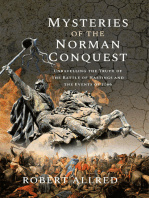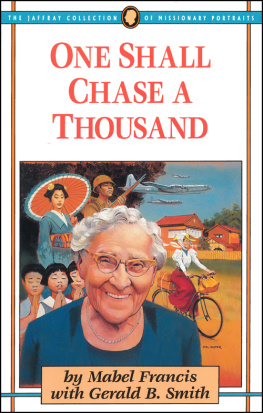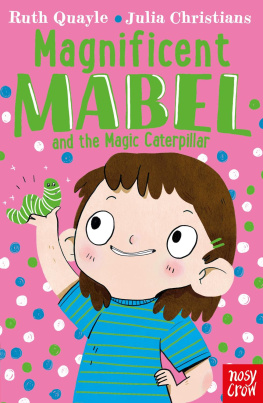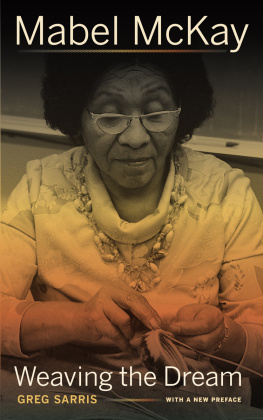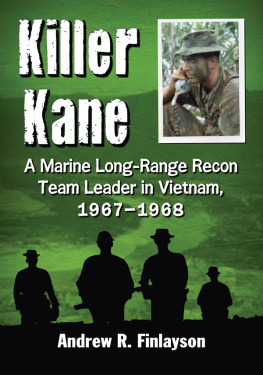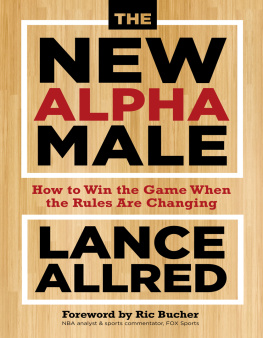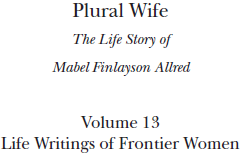
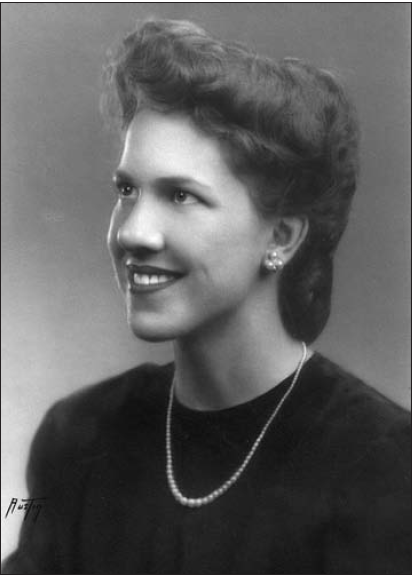

2012 by the University Press of Colorado
Published by Utah State University Press
An imprint of University Press of Colorado
5589 Arapahoe Avenue, Suite 206C
Boulder, Colorado 80303
The University Press of Colorado is a proud member of

| The Association of American University Presses. |
The University Press of Colorado is a cooperative publishing enterprise supported, in part, by Adams State College, Colorado State University, Fort Lewis College, Metropolitan State College of Denver, Regis University, University of Colorado, University of Northern Colorado, Utah State University, and Western State College of Colorado.
All rights reserved
Manufactured in the United States of America
ISBN: 978-0-87421-874-9 (cloth)
ISBN: 978-0-87421-875-6 (e-book)
Library of Congress Cataloging-in-Publication Data
Allred, Mabel Finlayson, 1919-2005.
Plural wife : the life story of Mabel Finlayson Allred / edited by Martha Bradley-Evans.
p. cm. (Life writings of frontier women ; v. 13)
ISBN 978-0-87421-874-9 (cloth : alk. paper) ISBN 978-0-87421-875-6 (e-book)
1. Allred, Mabel Finlayson, 1919-2005. 2. Apostolic United BrethrenBiography. I. Bradley-Evans, Martha. II. Title.
BX8680.M58A75 2012
289.3092dc23
[B]
2012013278
Table of Contents
Illustrations
Photographs
.
.
.
.
.
.
.
.
.
Introduction
Martha Bradley-Evans
Importance of the Document
I grew up in Salt Lake City, Utah in the 1950s in a subdivision of ranch style homes at the foothill of Mount Olympus. Our family had one father and one mother, three brothers and myself, the sole and lonely sister. We were Mormons. We read the Bible and the Book of Mormon. We sang the hymns, The Spirit of God Like a Fire is Burning and Come, Come Ye Saints with all the fervor of the righteously indignant. The persecution narrative of our pioneer forefathers and mothers inscribed our memory. Their story was in us, their journey our journey.
On the other side of the valley, a Mormon girl of similar ageDorothy Allredgrew up in a very different household. Although our parents and teachers would have taught us much of the same wisdom and we might have testified to the same beliefs, our familial structure could not have been more disparate. For my three brothers, she had four; but her half brothers and sisters numbered forty-four more. Although her mothers only daughter, a position I shared, Dorothy was one of many to her father in a family of towheaded blondes with blue eyes that mirrored the sky. Her mother, Mabel Finlayson Allred, was the fourth wife to Rulon C. Allred, the head of a group of Mormon Fundamentalists who lived subterranean lives just beneath the surface of respectable mainstream culture. Their lives were rich and full, but lived where outsiders could not observe. They were private, inclusive and dedicated to God.
Editorial Policies
This text contains a remarkable consistency of voice and allows the reader to experience a rich sense of Mabel Finlayson Allreds personality. One can almost hear Mabel speak as words are read.
The provenance of the document itself is complex and layered with the soft touch of family. Mabel began thinking about her autobiography soon after her twin sister Melbas death in 1998. The first volume she produced is dated both 2000 and 2001. The second volume is dated 2001, 2002, 2003, and 2004. When she completed her writing in 2004, she gave the hand written document to her daughter-in-law Bonnie Allred who typed it, made some adjustments in grammar, style, language and even added some new stories, dates and names for clarification. Mabel edited that version, made changes and wrote editorial notesinserts that she wanted included in the final draft. A second typed version included subheadings. These inserts and comments are included in this version of the text of the autobiography.
The document itself provides another kind of evidence about Mabel Allred. It was written on simple lined paper in pencil, the kind a child would take to school in a notebook. Her daughter Dorothy recalled, She had lovely handwriting. And even at her age, she was very meticulous. Mabel talked with Dorothy about the changes she wanted made in the first typed version and urged her to ensure that the final version reflected Mabels own words, expressive spirit and intent. After these conversations and understanding her mothers desire to get it right, Dorothy and her brother, Jerry, edited the document and inserted the changes that Mabel requested. The result was a typed third version that again included a combination of original text, editorial changes and elaborations, and the handwritten changes Mabel had requested.
After considering the original hand written copy, the various typed versions including the third with Dorothy and Jerrys editorial changes, I made the editorial decision to return to the original and to include the changes Mabel penciled in on the first typed version which provided clarification to her original document. I have made only occasional and minor changes in punctuation. The original handwritten document, and the penciled in comments on the typed draft produced by her children, are Mabels own words and form the content of this autobiography rather than interpretations or edits of the autobiography by others. My decision was complicated by the fact that at least three individuals, possibly four, worked on the document after Mabel produced it, resulting in a manuscript quite different from the one initially envisioned. In the spirit of capturing her own authentic voice, rhythm and style, I have tried to peel back those layers of change and return to her original choice of words, emphases and intent. At points, I add words in brackets to help the flow of language and create greater clarity. Footnotes provide additional explanatory information to help the reader understand the context or meaning of a coded word or event.
Mabels language is embellished with punctuation that brings a type of musical quality to her work. She used commas extravagantly and italics for emphasis in most paragraphs. I do not correct or delete these choices as they are extremely important in terms of capturing the cadence of her speech or the dramatic flare she might have used to tell her story. They help us imagine her speaking, perhaps holding one of her precious grandchildren on her lap, stroking her hair as she let her memories engulf her, or sitting at a family dinner table recounting the familiar narrative of her courtship and marriage, the 1944 raid, or her return to the LDS Church. Occasionally, Mabel left out a critical word, or left a word incomplete. In these instances, brackets enclose words that help clarify or signal changes made based on perceived intent. Other editorial comments are biographical or explanatory in nature, or supply dates to the narrative.
Mabels love of music, her ebullient and optimistic spirit ring through her words and I respect the integrity of the language she chose to use. Hers is a unique story, one she wanted preserved for her grandchildren and their children. It is laced with a strong sense of heaven and earth, a love of God and human beings, and Mabels joy in her everyday life. Her gratitude for the time spent with her family was immense, and she comments that she wrote the story in part out of thankfulness to her Heavenly Father, expressing her gratitude for blessing me so abundantly as He has throughout my life! Without Him. I would have been, or felt, lost! So, I praise His name, and will try my best to be worthy of His goodness to me (p. 98).
Next page

